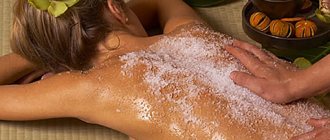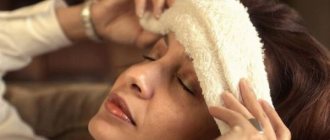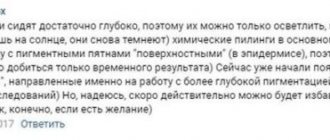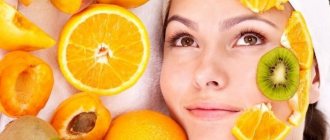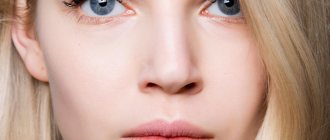REASONS FOR THE APPEARANCE OF STREAMS
The appearance of stretch marks (striae) is provoked by microtraumas of the skin and subcutaneous tissue (including cellulite). They appear when there is a hormonal imbalance and a lack of the hormone cortisol, which leads to protein deficiency and fragility of collagen fibers. As a result, when the skin is overstretched, tears form.
Stretch marks can appear in any person, regardless of gender and age, and there is often a genetic predisposition to this. At risk are:
| CATEGORIES OF PEOPLE | PROBLEM AREAS |
| Pregnant | Belly, chest |
| Adults and children suffering from sudden changes in weight | Waist, buttocks |
| Teenagers | Back and other rapidly growing parts of the body |
| Athletes gaining muscle mass | Shoulder girdle, hips |
Prevention
Since the appearance of stretch marks has underlying causes, their prevention should be based on an integrated approach:
- Balanced nutrition - it is necessary to introduce into the diet foods that increase the elasticity and regenerative abilities of cells: with vitamins C, B, E, A, P, phosphorus, magnesium, fatty acids (fish, nuts, citrus fruits);
- Massages stimulate blood circulation in the vessels and restore nutrition to the epidermis. Typically, massage with patchouli, wheat or sea buckthorn oils containing vitamins A, E and C, or hydromassage is used.
- Cosmetics - stretch marks are less likely to form on well-moisturized skin, so it is recommended to regularly rub in creams and oils containing vitamins A, E and fruit acids. Also, masks, wraps and injections in the area of stretch marks are recommended to moisturize and increase elasticity;
- Peels (exfoliation) of various types not only restore the nutrition of the epidermis and cell elasticity, but also help remove skin damage.
Prevention
The best way to deal with any disease is to prevent it. There are a number of simple rules that must be followed in order not to encounter such a problem.
For prevention it is necessary:
- proper nutrition;
- massages and special treatments;
- cosmetical tools.
Proper nutrition
The body must receive a sufficient amount of vitamins C, B, E and A, which can be obtained by enriching your diet with fish, citrus fruits, and nuts. Essential fatty acids, which are obtained from pumpkin seeds and fish oil, must also be present in full. But you can’t overdo it with fatty foods - you need to adhere to the rules of balanced nutrition in order not to gain weight.
Massages and treatments
This can be either a simple massage at home or one done by professionals. Hydromassage helps against stretch marks, after which oil rich in vitamins A and E is rubbed into the skin. This not only helps to avoid stretch marks, but also moisturizes and rejuvenates the skin. It is good to rub avocado, grape, peach, almond, and apricot oils into the skin one by one.
There are various recipes for such oil massages.
First: based on sea buckthorn oil (2 tbsp) and a few drops of lavender essential oil.
Second: the same amount of flaxseed or olive oil with the addition of 2 drops of orange oil.
Third: 2 tbsp. l. flaxseed oil and a few drops of essential (rosemary and lemon balm).
Fourth: based on olive oil (9 tbsp.) with the addition of 1 tbsp. l. wheat germ and patchouli oil (5-10 drops).
You need to take care of your body with creams and oils not only after massages, but also on a daily basis. These products include any creams with vitamin A and/or fruit acids - they have moisturizing and rejuvenating properties. But you should carefully approach the problem of choosing one or another drug so that there is no individual allergic reaction to any of the drugs.
TYPES OF PEELING FOR STRETCH MARKS
Modern cosmetology offers many types of exfoliation, differing in components and methods of action. However, they all pursue one goal: to remove the stratum corneum of the epidermis and, as a result, to remove traces of stretch marks or at least make them less noticeable. Types of procedures are distinguished by the depth of impact (superficial, medium, deep) and method (mechanical, chemical and laser peels).
We recommend: ENZYMATIVE PEELING: how it borrows rejuvenation techniques from pineapple
Mechanical
The essence of mechanical peeling is to remove the top layer of skin using solid particles contained in scrubs or abrasive compounds.
The most popular mechanical peelings are:
- Scrubs, brushing - affect the granular and horny layers of the epidermis. They are usually used to remove young and micro-striae, or to prevent stretch marks.
- Microdermabrasion (diamond exfoliation, coral exfoliation) - applies to the papillary layer of the skin. Used for relatively young, medium-sized stretch marks.
- Dermabrasion - affects the reticular layer of the epidermis. The most traumatic of all. Dermabrasion is used in the most severe, advanced cases and only as prescribed by a doctor.
Mechanical peeling also functions as a massage, and you can prepare an exfoliating composition yourself.
Chemical
Another popular type of exfoliation is chemical peeling for stretch marks. In this case, getting rid of stretch marks occurs with the help of acids, which, unlike mechanical peeling, do not erase, but dissolve dead cells.
Chemical exfoliation also includes superficial, medium and deep action. The depth of exposure is regulated by the type of acid and its concentration in the peeling composition.
Chemical exfoliation is also good because acids not only remove excess layers of skin, but also provoke the remaining cells to increase the production of collagen and elastin, which becomes a preventive measure against future stretch marks.
Compositions based on the following acids are usually used against stretch marks:
- Amber;
- Retinoic;
- Glycolic;
- Phenolic;
- AHA acids.
Acids are often mixed to achieve a better effect (for example, as in the Jessner peeling from MedicControlPeel, which combines several types of acids that simultaneously affect relief, pigmentation and the production of collagen and elastin).
Hardware
This exfoliation is controlled either by the liquid gas or by the size and temperature of the laser beam. Laser peeling is usually used for deeper interventions.
The following types of laser peeling are used today:
- Fractional thermolysis;
- Laser resurfacing;
- Laser nanoperforation.
After the procedure, the skin is burned and may take several weeks to several months to fully recover. However, the result is worth it.
Mid peeling
Medium peeling is a more effective and more often used method against stretch marks, scars, scars, as it is performed using acid with a high level of penetration. This procedure is much better than superficial peeling, since the result is noticeable after a month.
Mechanical medium peeling
This type of peeling is carried out using special pressure substances, acids, which guarantees more in-depth cleansing and grinding. The only drawback is the frequency of the procedure. In order for the result to become noticeable, you need to carry out about 3-4 peelings.
Chemical mid-peel
Chemical peels can be a good treatment for fine lines and wrinkles and for resurfacing the skin. However, this type is not very effective against scars or stretch marks, as it requires deeper cleansing and treatment. This is a procedure for those who want to save on deep peeling and get a satisfying result.
Hardware medium peeling
This type of peeling is performed using a special device that cleanses the skin of excess dead cells, thus evening out the relief. For this purpose, acidic solutions are used, which, like other medium peels, penetrate deeply into the skin and cleanse it. In the fight against stretch marks, this method may not be very effective - it is more often offered to people with residual spots and scars. However, this procedure will work well with many visual problems.
PROS AND CONS OF THE PROCEDURE
The advantages of exfoliation are determined by the complexity of its action:
- Scars disappear or become less noticeable;
- Access to the papillary and reticular layers of the epidermis is opened, which stimulates restoration processes;
- The massage effect of mechanical peelings has a positive effect on blood circulation.
However, like any cosmetic procedure, peelings for stretch marks have their disadvantages:
- Swelling in the affected areas;
- Redness;
- Peeling;
- Bruising;
- Long recovery period when using any deep peels, as well as laser and chemical peels of medium impact.
We recommend: PEELING OF THE INTIMATE AREA in the salon and at home
Separately, it should be said about contraindications. Peeling is not recommended in the following cases:
- Diseases of the skin and blood vessels;
- Open wounds;
- Allergic reactions to the components of the exfoliating composition;
- Papillomas and suspicious moles;
- The use of certain hormones and medications that reduce blood viscosity;
- Keloids;
- Pregnancy (in consultation with your doctor).
Advantages and contraindications of the procedure
Any type of exfoliation facilitates access deeper into the skin, thins the stratum corneum and increases cell division. It also fights various blemishes, such as acne, stretch marks, minor scars and wrinkles.
Indications for the procedure:
- Scars, scars (any age);
- Stretches of varying depths;
- Age-related skin changes (wrinkles, aging);
- Acne and consequences of previous skin problems;
- Thickening of the surface layer of the skin (tinea versicolor, psoriasis, ichthyosis)
- Ingrown hairs;
- Increased pigmentation (freckles, chloasma).
Depending on the complexity and type of exfoliation procedure, there are absolute and relative contraindications. The category of absolute contraindications includes congenital and acquired diseases that require long-term treatment. Similar diseases include:
- Oncology. Cancer patients tend to have lower immune defenses, so chemical peels can cause unwanted complications, especially in people with melanoma;
- Heart diseases. Due to the property of rapid cell renewal, the procedure increases the load on the heart several times and can cause a heart attack;
- Individual intolerance to the components of the mixture. If you are prone to allergic reactions, you should consult a doctor before the procedure;
- Herpes. Peeling increases the load on the human immune system and reduces the body's protective functions, which leads to the proliferation of herpes cells.
Relative contraindications are temporary. Namely:
- Carrying a baby and feeding (about stretch marks on the chest).
- Infectious and viral diseases;
- Increased body temperature;
- Skin diseases during exacerbation;
- Pregnancy and lactation period;
- Use of medications (including Roaccutane, Benzoyl peroxide, Hydroquinone);
- Inflammatory and purulent processes of the skin.
Before you sign up for peeling for stretch marks, you must undergo a consultation to exclude contraindications to the procedure. The specialist should prescribe exactly the type of exfoliation that will bring the maximum positive effect. Article on the topic of facial waxing.
Most popular: List of inexpensive available analogues of Contractubex
HOW OFTEN TO DO
Using the procedure too often will cause new micro-tears in the skin, which will only worsen the problem of stretch marks. Therefore, for the procedure to bring a positive effect, it is advisable to adhere to the following schedule:
| Type of exfoliation | Treatment frequency |
| Surface | No more than 1-2 times a week as needed; |
| Median | From 3 to 10 sessions every 1-6 weeks, courses are repeated after 2-4 months; |
| Deep | It depends on the depth of atrophic changes and is prescribed by a doctor; most often it is a one-time procedure. |
The frequency of sessions and courses depends on the size and age of stretch marks, the types of peeling used and is determined by a specialist.
Chemical peeling
Chemical peeling for stretch marks is performed using solutions based on various acids and plant enzymes.
In fact, when applying the mixture, a chemical burn of the skin with stretch marks, controlled by a cosmetologist, results. The mechanism of action on stretch marks is that acids stimulate skin fibroblasts, which leads to collagen synthesis. In order for chemical peeling of the abdomen against stretch marks to give the greatest results, it is recommended from 4 to 6 sessions with an interval of 14 days. The final result will be noticeable only after 14 days, after a full course of procedures, which must be repeated after half a year.
TOP 8 HOME RECIPES
To prevent and remove small young stretch marks, you can peel stretch marks at home using available ingredients.
Coffee
Coffee is a product with vitamin PP, magnesium and phosphorus, which are responsible for cell regeneration. A safe scrub is recommended even in the most delicate situations, for example, after childbirth, and its frequent use is allowed.
The low-fat cream is combined with finely ground coffee (2 tsp) and mumiyo (4 g). Next, this mixture is applied to steamed skin and rubbed with a peeling washcloth in a circular motion into the problem area.
Citric
Lemon contains useful acids, vitamins A, C and B9, which are involved in the development and restoration of tissues, stimulating the production of elastin and collagen. Peeling is suitable for normal and oily skin and is often used to prevent and remove stretch marks on the abdomen. (Dry and sensitive people may react with irritation.)
There are several recipes for lemon peeling:
- Mix the grated zest of one lemon and 100 g of sour cream, add 2 drops of rosemary essential oil. Rub the mixture into the desired area of skin, leave for 20 minutes, and rinse.
- Combine equal parts lemon juice and water, apply to skin and rinse after 15 minutes.
After the procedure, it is important to use a moisturizer: lemon juice can dry out the skin. Use no more than once every 1-2 weeks.
With badyaga
Badyagi contains silicon, which, when it gets on the skin, stimulates blood flow and elastin production.
We recommend: PEELING OR FACIAL CLEANING: WHAT IS BETTER? | 5 differences
Bodyaga “works” in tandem with 3% hydrogen peroxide in a 1:1 ratio. Problem areas of the skin are wiped with the mixture and left to act for 15 minutes. Usually 10 sessions are enough for daily use.
Before using this peel, it is advisable to conduct an allergy test. In addition, badyaga is contraindicated during lactation and pregnancy.
Almond
Gentle almond peeling for stretch marks is suitable even for very sensitive and thin skin and is approved for frequent use. Mandelic acid gently exfoliates, has a lifting effect and does not dry out the skin.
Almond kernels and oatmeal are ground to a powder and mixed. This mixture is then combined with mandelic acid and aloe juice. The scrub is rubbed into the skin for several minutes and washed off.
BIO OIL, 23€ MAMA MIO, 52€ PALMERS, 5€
With iodine
Iodine peeling for stretch marks must be used with caution, since iodine can cause severe burns. The method is also contraindicated for sensitive skin and during pregnancy and lactation.
For stretch marks on the skin, a 5% iodine solution is used, which is applied to problem areas 4 times a day for 3 days. As a result, the roughened, burned tissue begins to peel off and is replaced by new, scar-free tissue. However, it is highly undesirable to use iodine peeling more than once every 2 months.
Soda
Baking soda cleanses well, brightens and gently exfoliates. To prepare a soda scrub, mix baking soda and finely ground salt in 1:1 proportions. Next, the mixture is rubbed into the skin with gentle movements for 1-12 minutes, after which it is washed off. After peeling, you need to apply a moisturizer. Use no more than once a week.
Phytopilling
Phytopilling uses only plant components, and its ingredients can be combined at will. Any ingredients can be added to the mixture: sea salt, lemon juice, badyaga, extracts of flax seeds and eleutherococcus, etc.
The resulting composition is applied to the skin for 15-20 minutes, or rubbed in for 1-2 minutes if solid particles are present.
With seaweed
Algae contain iodine, vitamins A, B, C, are used in medicine to improve tissue regeneration and are sold in pharmacies.
The wrap is done as follows: the seaweed is soaked in water for 20-30 minutes, then applied to the skin that has been previously cleaned with a scrub. The treated areas are wrapped in film, then warm clothes are put on top and left for 1 hour. After which the composition is washed off.
Text author: Alexandra Gribovskaya
Leave a review, did you manage to get rid of stretch marks and how?
Dandelion and aloe cream for stretch marks.
To prepare the cream you need 100 grams of fresh or frozen dandelion leaves, 75 grams of olive oil, several aloe vera leaves or 1 tsp. aloe juice and oatmeal (to give the composition viscosity). Place dandelion leaves, olive oil and aloe leaves, cut into slices, into a blender and smash until smooth. Add oatmeal to the resulting slurry until the mixture becomes creamy. This paste should be applied directly to the areas of the skin where there are stretch marks, left for a while, then rinsed with warm water. Keep refrigerated. Apply the cream morning and evening. The cream is good for a week, then make it fresh. Use this cream until the stretch marks disappear completely. No one will believe that you had them!
Concepts of aesthetic medicine
At home, you can make stretch marks less noticeable, but getting rid of them completely in this way is impossible, and a trip to specialists is inevitable. Prevention and cosmetics help reduce the size of the problem and slow its spread.
Aesthetic medicine provides the following range of services to get rid of stretch marks:
- subcutaneous injections;
- seaweed wraps;
- laser peeling;
- chemical peeling.
Laser peeling
Laser peeling is considered a radical way to get rid of stretch marks. It is based on the fact that after exposure to certain waves, the skin will increase the production of elastin fibers and collagen.
Using lasers of varying sizes and temperatures, stretch marks are either completely destroyed or become barely visible if the scars are very old or deep. Two months before the operation, it is necessary to begin preparation: a cream rich in vitamin C is rubbed into the skin. The procedure itself takes place under anesthesia: local or general - it depends on the severity and depth of the scars.
How to get rid of stretch marks surgically
Surgical intervention is resorted to only in cases where all of the above measures have not had the desired effect. The plastic surgery methods that aesthetic medicine offers us are extensive. They are resorted to if the skin on the abdomen is very sagging, then the sagging area along with the scars is removed using abdominoplasty. However, after the operation there will be a scar.
In conclusion, it should be noted that the development of cosmetology is proceeding at such a pace that there is no doubt about a positive result. Every year, new and more improved methods for correcting the figure and face are offered on the market, using which you can remove stretch marks once and for all.
